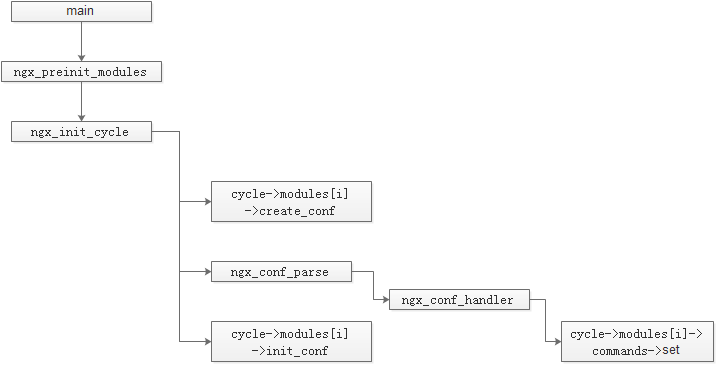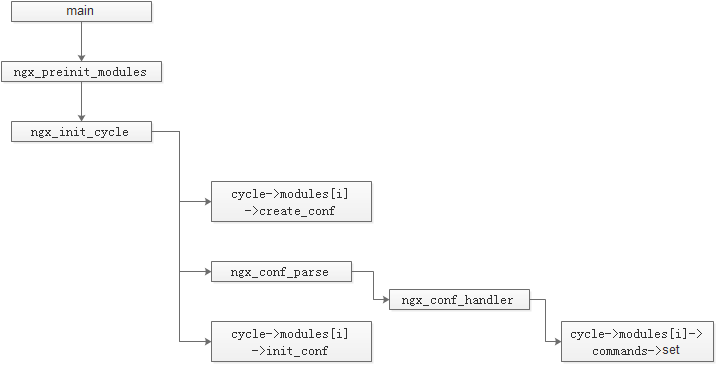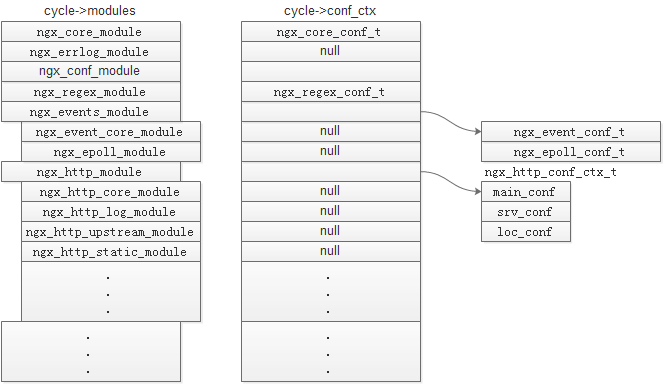nginx的代码是以模块的形式组织起来的,当我们执行完configure后会生成ngx_modules.c, 这个文件中记录了nginx的所有模块(包括扩展模块):
ngx_module_t *ngx_modules[] = {
&ngx_core_module,
&ngx_errlog_module,
&ngx_conf_module,
&ngx_regex_module,
&ngx_events_module,
&ngx_event_core_module,
&ngx_epoll_module,
&ngx_http_module,
&ngx_http_core_module,
&ngx_http_log_module,
...
}
我们先来看下nginx的模块结构图:

ngx_cycle_t在程序启动时被创建,且是全局唯一的。ngx_cycle_t中的modules是ngx_module_t数组,初始值从ngx_modules拷贝。ngx_module_t关联一个或多个ngx_command_t对象,这个对象大有用处,一来它是创建次级模块的入口,二来它负责读取配置。ngx_*_module_t是模块的上下文对象,它用于模块的个性化定制,一般来说,同一类别的模块拥有相同的上下文对象。 如,NGX_CORE_MODULE类别的模块拥有ngx_core_module_t类型的上下文对象;NGX_EVENT_MODULE类别的模块拥有ngx_event_module_t类型的上下文对象。ngx_cytle_t结构体中还有conf_ctx成员,它也是一个数组,初始化为跟modules一样的大小,conf_ctx用于存储模块的配置。
nginx的所有模块都是存放在ngx_cycle_t结构的modules数组中的,在内存中它们是线性的,但在逻辑上它们是分层的。
我们用下面的示意图展示模块的分层结构:

nginx中的模块根据类型字段(ngx_module_t->type)进行了分层、分组:
- 顶层为
NGX_CORE_MODULE类型的模块,它们的上下文对象为ngx_core_module_t类型。 顶层模块可接入二层模块,一般通过ngx_command_t结构中的set方法来接入。 如,NGX_EVENT_MODULE模块组就是通过ngx_events_block方法接入的。 - 二层
NGX_EVENT_MODULE模块组是通过顶层模块ngx_events_module接入的; 二层NGX_HTTP_MODULE模块组是通过顶层模块ngx_http_module接入的。 具体是怎么接入的我们在下面讨论。
上面的分层模块图有些模块是加粗的,这些模块是组织模块,负责本模块组的管理,未加粗的则是实际干活的功能模块。
我们接下来看看,二层模块是如何从顶层模块接入的:

ngx_preinit_modules负责所有模块初始化:
ngx_int_t ngx_preinit_modules()
{
ngx_uint_t i;
ngx_max_module = 0;
for (i = 0; ngx_modules[i]; i++) {
ngx_modules[i]->index = i;
ngx_modules[i]->name = ngx_module_names[i];
}
ngx_modules_n = i;
ngx_max_module = ngx_modules_n + NGX_MAX_DYNAMIC_MODULES;
return NGX_OK;
}
cycle->modules[i]->ctx->create_conf和cycle->modules[i]->ctx->init_conf只针对顶层模块,用来创建和初始化各模块的配置。
ngx_conf_parse读取并解析配置文件,解析完配置后调用ngx_conf_handler。
ngx_conf_handler遍历模块的命令数组,然后根据配置项与命令参数一一对比,如果符合,则调用命令结构的set函数。
注意,set函数就是接入二层模块的关键。
对于不负责接入的功能模块,set函数一般置为设置配置的函数。
比如,ngx_errlog_module的commands定义为:
static ngx_command_t ngx_errlog_commands[] = {
{ngx_string("error_log"),
NGX_MAIN_CONF|NGX_CONF_1MORE,
ngx_error_log,
0,
0,
NULL},
ngx_null_command
};
ngx_error_log定义如下:
static char *ngx_error_log(ngx_conf_t *cf, ngx_command_t *cmd, void *conf)
{
ngx_log_t *dummy;
dummy = &cf->cycle->new_log;
return ngx_log_set_log(cf, &dummy);
}
而对于需要接入二层模块的顶层模块,主要就是依赖set函数来完成二层模块的接入了。
我们来看下ngx_events_module的commands成员的定义:
static ngx_command_t ngx_events_commands[] = {
{ ngx_string("events"),
NGX_MAIN_CONF|NGX_CONF_BLOCK|NGX_CONF_NOARGS,
ngx_events_block,
0,
0,
NULL },
ngx_null_command
};
NGX_EVENT_MODULE模块组就是在ngx_events_block函数中接入的。
为了把二层模块的接入过程阐释清楚,我们完整的展示下ngx_events_block函数的定义。
所有的二层模块的接入过程基本类似,我们自己写nginx的扩展的时候,最好也参照现有方法。
static char *
ngx_events_block(ngx_conf_t *cf, ngx_command_t *cmd, void *conf)
{
char *rv;
void ***ctx;
ngx_uint_t i;
ngx_conf_t pcf;
ngx_event_module_t *m;
if (*(void **) conf) {
return "is duplicate";
}
/* count the number of the event modules and set up their indices */
ngx_event_max_module = ngx_count_modules(cf->cycle, NGX_EVENT_MODULE);
ctx = ngx_pcalloc(cf->pool, sizeof(void *));
if (ctx == NULL) {
return NGX_CONF_ERROR;
}
*ctx = ngx_pcalloc(cf->pool, ngx_event_max_module * sizeof(void *));
if (*ctx == NULL) {
return NGX_CONF_ERROR;
}
*(void **) conf = ctx;
for (i = 0; cf->cycle->modules[i]; i++) {
if (cf->cycle->modules[i]->type != NGX_EVENT_MODULE) {
continue;
}
m = cf->cycle->modules[i]->ctx;
if (m->create_conf) {
(*ctx)[cf->cycle->modules[i]->ctx_index] =
m->create_conf(cf->cycle);
if ((*ctx)[cf->cycle->modules[i]->ctx_index] == NULL) {
return NGX_CONF_ERROR;
}
}
}
pcf = *cf;
cf->ctx = ctx;
cf->module_type = NGX_EVENT_MODULE;
cf->cmd_type = NGX_EVENT_CONF;
rv = ngx_conf_parse(cf, NULL);
*cf = pcf;
if (rv != NGX_CONF_OK) {
return rv;
}
for (i = 0; cf->cycle->modules[i]; i++) {
if (cf->cycle->modules[i]->type != NGX_EVENT_MODULE) {
continue;
}
m = cf->cycle->modules[i]->ctx;
if (m->init_conf) {
rv = m->init_conf(cf->cycle,
(*ctx)[cf->cycle->modules[i]->ctx_index]);
if (rv != NGX_CONF_OK) {
return rv;
}
}
}
return NGX_CONF_OK;
}
函数调用流程如下:

是不是跟ngx_init_cycle中初始化顶层模块的过程很像?
NGX_EVENT_MODULE模块组的初始化过程也是三步:
- 调用上下文对象中的
create_conf方法创建配置 - 调用
ngx_conf_parse加载事件模块配置 - 调用上下文对象中的
init_conf完成初始化
不过需要注意的是,事件模块中的上下文对象是ngx_event_module_t结构;
而顶层模块中的上下文对象是ngx_core_module_t结构,虽然它们拥有相同的配置创建和初始化函数,但它们是来自不同的结构体。
最后,我们通过下面的示意图来展示下ngx_cycle_t结构中的模块数组和配置数组,以及二级模块的配置存放方式:

«Previous: 单元测试
»Next: 安装CentOS7.0后的系统配置及软件安装备忘